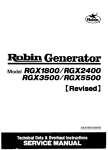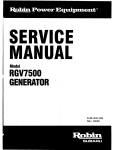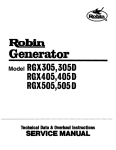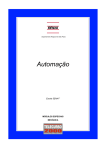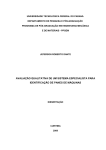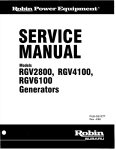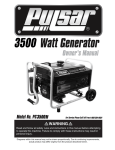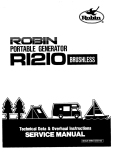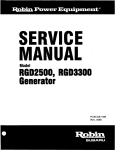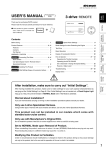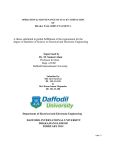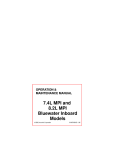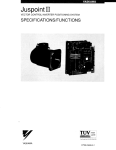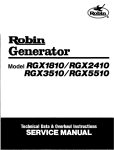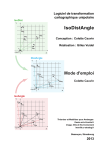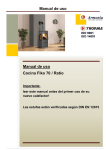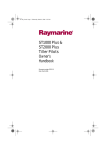Download RGX1800/2400/3500/5500 GNERATOR SERVICE MANUAL
Transcript
MANUAL
Models
RGXI800,*.RGX2400,
RGX3500,RGX5500
Generators
PUB-GS0597B
Rev. 8198
.
.
.
i
Model
RGX1800
--
~~~~
RGX2400
~~
_ _ _ ~
~
~
TY Pe
Frequency
I
I
I
50Hz
Maximum Output
16ow
Rated Output
1300W
Rated
11OV
I
11.8A
220V
I
I
240V
60Hz
"I
~
1800W
~~
1500W
5.9A
1
I
120V
5.4A
I
220V
11OV
I
1
I
I
I
.-, . ."
2000w
I
15.5A
I
11OV
I
18.2A
12.5A
220V
7.7A
I
120V
240V
7.1A
I
220V
I
I
16.7A
6.8A
I
I
Voltage Regulator
Condenser Type
Voltage Regulation
Within 10%
1 OVl22OV
1
18.2Al9.1A
-
12OVl24OV
16.7Al8.3A
Robin Air-Cooled 4-Cycle Gasoline Engine
Type
Model
EY20D
Displacement
183cc (11.17 cu. in.)
Rated Output
3.5 HP13600rpm
Automobile Gasoline
Fuel
10 liters (2.64US. gal.)
Fuel Tank Capacity
50Hz: 1.O liters/hour
60Hz: 1.3 literslhour
Fuel Consumption Ratio
(at Rated Output)
Oil Capacity
50Hz: 1.1 liters/hour
60Hz: 1.4 liters/hour
600 cc
Recoil Starter
..
552 X 377 X 482 mm
(21.7 X 14.8 X 19.0 in.)
Dimensions L x W X H
Ibs.) (97
kg
45
I
9.1A
15.5AR.7A
1.o
12V-8.3A (1OOW)
Dry Weight
I
11OV
DC Output
Starting
System
.
" "_
2400W
13.6A
-
-.
60Hz
7
1700W
11OV122OV
Power Factor
-.
~
I
50Hz
2000w
Current
."
~~~
Brushless, Revolving Field, Self-Exciting,-2-Pole, Single Phase
Ibs.) (100 kg 45.5
I
-
i
I
I
Model
I
RGX3500
~
~
~
~
RGX5500
~~~
~
Brushless, Revolving Field, Self-Exciting,2-Pole, Single Phase
TY Pe
Frequency
.""
Rated Output
Voltage
Current
50HZ
60Hz
3000W Maximum Output 3500W
5000W
5500W
3000W
4400W
4800W
,
110v
22.7A
110v
26.4A
110v
40A
110v
43.6A
220v
11.4A
120v
24.2A
220v
20A
120v
40A
240V
10.4A
220v
1 OV1220V
1
22.7AIl1.4A
-
-.. . ..
L.-
60Hz
- ..
2500W
Rated
,. .. ..
I
50Hz
"
18.3A 240V 220v
13.2A
1 OV1220V
1
26.4Al13.2A
1 OV1220V
1
40Al20A
120V1240V 24.2N12.1A
-
-
"
.
-
"
"
-
1 OV1220V
1
43.6AI21.8A
40AI20A 120V1240V
1.o
Power Factor
DC Output
12V-8.3A (1OOW)
Condenser Type
,
"
Voltage Regulator
"-
.
"
Within 10%
Voltage Regulation
"
Iu
I
Robin Air-Cooled 4-Cycle Gasoline Engine
TY Pe
Model
I
EY40D
I Displacement
Output
I Rated
I
I
~
~~
I
I
273 cc (16.66cu. in.)
5.5
rpmHP/3600
(23.68
cc388
HP13600 8.0
EY28D
cu. in.)
rpm
Automobile Gasoline
-.-
-.
W
"
Fuel Consumption Ratio
(at Rated Output)
- ".
"
"
60Hz: 3.1 literdhour
1200 cc
Recoil Starter and Optional Electric Starter
I
c
50Hz:2.7 literslhour
50Hz: 1.8 literdhour
60Hz:'2.1 literslhour
850 cc
Starting System
Dry Weight
I
I
Oil Capacity
Dimensions L X W X H
15.5 liters (4.10U.S. ghl.)
13 liters (3.43U.S. gal.)
21.8A
I
552 X 413 x 520 mm
(21.7 X 16.3 x 20.5 in.)
635 X 448 X 596 mm
(25.0 X 17.6 X 23.5 in.)
56 kg (123.5 Ibs.)
76 kg (167.6 Ibs.)
2. PERFOMANCE CURVES
2-1 MODEL RGX1800
I
3
6
9
CURRENT {A)&
12
15
+
-3-
1.5k
u
U
-1k
t
-3
5
n
t3
-0.5k 0
->
I
W
U
-0
a
5
0
>
bk
c1.5k
rz
0.5k
2
3
I-
2
-0.5k o
-0
CURRENT (A)
+
-4-
2k
1.5k
lk
t
iz
3
n
I-
3
0.5k
o
0
>
CURRENT (A)-
2k
1.5k
lk
t
I-
3
n
I-
3
0.5k
0
0
3
6
9
12
15
CURRENT (A)+
2-2 MODEL RGX2400
+
5
0
>
CURRENT (A)-
-5-
4
CURRENT (A)+
0
4
a
12
16
20
CURRENT (A\+
4
-2 k
- t
1
-1k
-
3
I-
2
I-
3
0
-0
CURRENT (A)”--.)
-6-
t
c
>.
L:
z
w
3
z
62
61
IZt 1
60
59
K
U
1
->w
-1k
t-
-
3
0
240
220
2I-
-c
200
u
a
5
0
>
0
2
4
a
6
10
12
CURRENT (A)+
-2k
- t
is
I
-1k
E
d
n
I-
3
0
_."
-0
CURRENT iAl+
r
t
0
4
-
8
12
CURRENT (A)
16
20
-7-
4
8
12
CURRENT ( A )
16
20
2-3 MODEL RGX3500
t
52
51
50
L
49
120
110
100
0
10
20
30
CURRENT (A!-
- 4k
63
t
62
-3k
61
60
3
59
-2k
120
-1k
2
k
6
110
-0
100
0
10
20
30
CURRENT (A)-
-a-
- 4k
>V
z
w
- 3k
za
-2k
3
U
:-
1k
CURRENT (A)+
-3k
z
-2
t
-3
I-
3
t
-1k
3
0
-0
>
4
8
CURRENT [A)-
12
t
14k
U
t
->
G
/-
0
a
I-
d
0
>
CURRENT (A)-
-9-
N
I
%
i,
z
W
3
U
W
a
Y
->
W
CY
a
I-
-I
3
>
W
3
ElCT
LL
0
5
0
10
20
30
CURRENT [A!-
LL
W
U
a
i-
-1
C
>
-1
CURRENT [A)-
- 10-
- 4k
-3k
-2k
t
s
3
a.
t
3
-1k
0
-0
2-4 MODEL RGX5500
-3k
3
I-
-2k
2
I-
-1k
-0
CURRENT (A)-
t
>
0
z
u
3
0
K
U
CURRENT (AI+
- 11
-
3
0
62
61
60
59
130
120
LO
110
0
t-
20
30
40
50
52
51
5
50
Ej
49
z
10
3,
L=
U
t
2
240
220
LO
200
w
13
a
t
-1
2
0
~
-I
N
z
5
5
10
15
CURRENT (A)-
20
25
- 6k
61
:-t-
60
53
4k
cl
-3k
I
L
a
U
f
->
3
240
-2k
220
-1k
200
LO
3
0
I
LLI
(3
<
t
-1
0
>
0
5
10
15
20
25
CURRENT [A)-
- 12-
a
U
CURRENT (A)-
- 5k
I-
zt-
-2k 3
0
t
->
~
lk
W
a
a
-1
0
>
C U R R E N T (AI
t
-
-0
r
i
6k
a
U
- 13-
6k
I:,
5
c
-3k
3
a
I-
3
-2k
o
rlk
i
CURRENT [A)-
2-5 DC OUTPUT
Thevoltagecurveshownintheleftindicates
the
characteristic of DC output when charginga battery.
Thevoltage may bedecreasedby
20% whenthe
resistance load is applied.
NOTE: It is possible to use both DC and AC outputs simultaneously up to the rated output
in total.
- 14-
3. FEATURES
3-1 BRUSHLESS ALTERNATOR
Newly developed brushless alternator eliminates troublesome brush maintenance.
3-2 CONDENSER TYPE VOLTAGE REGULATOR
A trouble free condenser type voltageregulatorensuresastablevoltage
conditions.
under all working
3-3 OIL SENSOR
Oil sensor automaticallyshuts off the engine wheneverthe oil level falls down below the lower limit
to protect the enginefrom seizure.
3 4 QUIET OPERATION
Robin RGX series generator delivers a quiet operation with
:
0 A large super silentmuffler.
0 A quiet 4-stroke Robin engine.
0 A silent cycloneair cleaner.
3-5 NO RADIO NOISE
Noise suppressor spark plug and spark plug cap are equipped standard to prevent radio frequency
interference.
3-6 LARGE FUEL TANK
The large fuel tank allows morethan 5 to 10 hours of continuous operation whichis sufficient for a
half day or one day work without refueling.
3-7 RUGGED TUBULAR FRAME
Full cradle typerugged tubuler frame protectsthe generator allaround.
3-8 COMPACT AND LIGHT WEIGHT
Newly developed brushless alternator enabled the RGX generators to be very compact in s u e and
light in weight.
3-9 MINIMAL MAINTENANCE
0
0
0
0
0
0
A brushless alternator release the operator
from periodical brush maintenance.
A trouble free condenser type voltage regulator.
A drip-proof alternator design.
No-fuse circuit breakers.
An electronic pointless ignition system.
A dust-proof cyclone air cleaner.
3-10 LONG-LIFE DURABILITY
The heav-duty 4 stroke Robin engine and virtually maintenance-free brushless alternator ensure
greater durabilitywith :
0 A brushless alternatorwith a condenser voltageregulator.
0 Full rubber mount in a sturdy tubular frame.
0 A forged steel crankshaft supported by two main ball bearings.
0 A pointless electronic ignition system.
0 A cast iron cylinderliner.
0 A forged aluminum connectingrod.
- 15-
4. GENERAL DESCRIPTION OF THE GENERATOR
4-1 EXTERNAL VIEW Of GENERATOR
F U L L POWER SWITCH
(DUAL VOLTAGE TYPE)
EARTH
(GROUND)
TERMINAL
FUEL
(RGX3500 OIL
NO FUSE BREAKER
(RGX1800.2400: CIRCUIT BREAKER)
-1
COCK
PLUG COVER (SPARK PLUG, INSIDE)
RAINING
e
VOLTMETER
(PILOT LAMP)
TERMINAL
/
PLUG
7NK
CAP
OUTPUT
- 16-
GAUGE
DC
4-2 CONTROL PANEL
0
RGXl800 :50HZ-11OV, 60Hz-120V TYPE
VOLTMETER
CIRCUIT
DC
RGX2400 : 50HZ-11 OV, 60Hz-12OV TYPE
CIRCUIT BREAKER
VOLTMETER
\
DC FUSE
\
TP-
0
0
AC RECEPTACLE
EARTH (GROUND) TERMINAL
DC OUTPUT TERMINAL
- 17-
RGX1800, RGX2400 :50Hz-220VY 240V, 60HZ-220VTVPE
VOLTMETER
-
\
DC FUSE
AC RECEPTACLE
DC OUTPUT TERMINAL
EARTH (GROUND1 TERMINAL
RGX1800, RGX2400 :5OHZ, 60H~-llOV/220VTYPE
CIRCUIT BREAKER
F U L L POWER SWITCH
\
220V RECEPTACLE
\
VOLTMETER
110V RECEPTACLE
EARTH
DC OUTPUT TERMINAL
- 18 -
(GROUND) TERMINAL
RGXl800,2400 :U.K., 50H~-llOV/12OV[BSRECEPTACLE]
"
CIRCUIT BREAKER
VOLTAGE CHANGEOVER SWITCH
\
VOLTMETER
220V RECEPTACLE
"-----
i
A l l O V RECEPTACLE
DC FUSE\
DC OUTPUT TERMINAL
EARTH (GROUND) TERMINAL
RGX2400 : U.S.A., 60Hz-120V [NEMA RECEPTACLE]
PILOT LAMP
\
\
/
IDLE C O N T R C
(Option)
CIRCUIT BREAKER
120V RECEPTACLE
\
EARTH (GROUND) TERMINAL
- 19-
RGXl800,2400 GERMANY,50HZ-220V
CIRCUIT BREAKER
t
I AC
A
22OVl
220V RECEPTACLE
\
EARTH (GROUND) TERMINAL
DC OUTPUT TERMINAL.
RGX1800,2400 :50Hz-220V [WITH SPECIAL RECEPTACLE]
CIRCUIT BREAKER
/
VOLTMETER
0
DC FUSE
T
J
J
1
+
0
220V RECEPTACLE
\
EARTH (GROUND) TERMINAL
DC OUTPUT TERMINAL
- 20 -
RGXI800,2400 :SWITZERLAND, 50Hz-220V
CIRCUIT BREAKER
OFF
-ni
DC FUSE
\
c
I
AC
220V
I
3
voILTMETER
L
22QV RECEPTACLE
\
DC OUTPUT TERMINAL
EARTH (GROUND) TERMINAL
RGXl800,2400 :AUSTRALIA, 5OHZ-240V
-
CIRCUIT BREAKER
/
. - - -
DCFUSE
VOLTMETER
24QV RECEPTACLE
OUTPUT
DC
- 21 -
RGX3500 :50HZ-11OV, 60Hz-120V TYPE
NO-FUSE BREAKER
VOLTMETER
START SWITCH
(Option)
I
\
/
AC RECEPTACLE
SE
DC F’
F
DC OUTPUT TERMINAL
EARTH (GROUND) TERMINAL
RGX3500 : 50H~-220V,240V, 60Hz-220V TYPE
NO-FUSE BREAKER
VOLTMETER
START SWITCH
(Option)
\
DC FUSE
AC RECEPTACLE
0
/
\
\
C
/
C
DC OUTPUT TERMINAL
EARTH (GROUND) TERMINAL
- 22 -
0
RGX3500 :5OHZ, 60H~-llOV/220VTYPE
(Option’
NO-FUSE BREAKER
F U L L POWER SWITCH
START SWITCH
\
\
VOLTMETER
/
/ Dc FUSE
-
AC RECEPTACLE
k
3
AC
7
0
DC OUTPUT TERMINAL
EARTH (GROUND) TERM~NAL
RGX3500 :U.K., 50H~-llOV/22OV [BS RECEPTACLE]
START SWITCH
(Option)
VOLTAGE
CHANGEOVER
SWITCH
NO-FUSE BREAKER
/
\
:DC FUSE
VOLTMETER
220V RECEPl
Lo
,/
l l O V RECEPTACLE
J
EARTH (GROUND) TERMINAL
- 23 -
DC OUTPUT TERMINAL
RGX3500 :U.S.A., 60H~-120V/24OV[NEMA RECEPTACLE]
FULL SWITCH START
(Option)
BREAKER
POWER
NO-FUSE
SWITCH
IDLE CONTROL
(Option)
VOLTMETER
240V
120V RECEPTACLE
\
EARTH (GROUND) TERMINAL
RGX3500 : GERMANY, 50Hz-220V
START SWITCH
(Option’
\
NO-FUSE BREAKER
VOLTMETER
I
/
/Dc
2 2 0 v RECEPTACLE
I
0
DC OUTPUT TERMINAL
EARTH(GROUND) TERMINAL
- 24 -
FUSE
RGX3500 :50HZ-220V [WITH SPECIAL RECEPTACLE]
'Option'
NO-FUSE BREAKER
VOLTMETER
START SWITCH
I
\
0
0
220V RECEPTACLE
DC
EARTH (GROUND) ~ E R M I N A L
OUTPUT TERMINAL
RGX3500 :SWITZERLAND, 50HZ-22OV
START SWITCH
(Option'
NO-FUSE BREAKER
VOLTMETER
I
\
~
220v RECEPTACLE
3
/
~~
,F
Jl
0
EARTH (GROUND) TERMINAL
- 25 -
DC OUTPUT TERMINAL
RGX3500 : AUSTRALIA, 50HZ-24OV
ER
SWITCH
START
(Option)
NO-FUSE BREAKER
\
/
/
0
DC FUSE
0
240V RECEPTACLE *
0
DC OUTPUT TERMINAL
EARTH (GROUND) TERMINAL
RGX5500 :50Hz-11OV, 60Hz-120V TYPE
VOLTMETER
DC FUSE
I
NO-FUSE BREAKER
I
/
AC RECEPTACLF
EARTH (GROUND) TERMINAL
- 26 -
START SWITCH
DC OUTPUT TERMINAL
RGX5500 : 50H~-22OV,240V, 60Hz-220V TYPE
DC
VOLTMETER
FUSE
NO-FUSE BREAKER
/
RECEPTACLE
AC
START
/
TERMINAL
OUTPUT
(GROUND)
TERMINAL
DCEARTH
RGX5500 : SOHZ, 60Hz-1 10V/220V TYPE
220V RECEPTACLE
\
l l Q V RECEPTACLE
EARTH (GROUND) TERMINAL
- 27 -
DC OUTPUT TERMINAL
0
RGX5500 : U.K.,
l l O V RECEPTACLE
220v RECEPTACLE
EARTH (GROUND)
TERMINAL
DC OUTPUT
TERMINAL
START SWITCH I
RGX5500 : U.S.A., 60H~-120V/240V[NEMA RECEPTACLE]
FULL
LAMP
PILOT
NO-FUSE BREAKER
POWER SWITCH
240V RECEPTACLE
\
0
IDLE CONTROL
!
120V RECEPTACLE
i
/
G
O
3
1
/
(Option)
START SWITCH
1
EARTH
(GROUND)
- 28 -
TERMINAL
RGX5500 : GERMANY, 50Hz-220V
DC
VOLTMETER
AC
FUSE
NO-FUSE BREAKER
220V
-
STARTSWITCH
220v RECEPTACLE
(GROUND)
EARTH
OUTPUT
TERMINAL
TERMINAL
DC
RGX5500 :50Hz-220V WITH SPECIAL RECEPTACLE]
VOLTMETER
*
kc
BREAKER
NO-FUSE
DC FUSE
220v
I
o
/
220v RECEPTACLE
EARTH
(GROUN'D) TERMINAL
- 29 -
DC OUTPUT TERMINAL
START
0
RGX5500 : SWITZERLAND, 5OHZ-220V
FUSE
DCVOLTMETER
NO-FUSE BREAKER
/
/START
220v R E C E P ~ A C L E
EARTH (GROUND) TERMINAL
DC OUTPUT
TERMINAL
RGX5500 :AUSTRALIA, 50Hz-240V
VOLTMETER
BREAKER
NO-FUSE
DC FUSE
/
r
AC
0
0
START SWITCH
@
/
0
24QV RECEPTACLE
/
EARTH (GROUND) TERMINAL
- 30 -
DC OUTPUT
TERMINAL
4-3 LOCATION of SERIAL NUMBER and SPECIFICATION NUMBER
Serial number and specification number are stamped on the LABEL (MODEL NAME) stuck on the end
cover.
NOTE: Always specify these numbers when inquiring about the generator or ordering spare parts in
order to get correct parts and accurate service.
LABEL, MODEL NAME
/
- 31 -
5. CONSTRUCTION AND FUNCTION
5-1 CONSTRUCTION
COMPLETE
ROTOR
COVER
STATOR
COMPLETE
REAR
COVER
END
MOUNT
RUBBER
STATOR
BOLT
BEARING
BALLTHROUGH
BOLT
SUPPORT RING
FRONT COVER
5-2 FUNCTION
5-2-1 STATOR
Thestatorconsists
of a laminated siliconsteel
sheet core, a main coil and a condenser coil which
are wound in the core slots.
Thecondensercoilexcites
the rotor field coil
which generates AC voltage in the main coil.
i
I
Fig. 5-2
- 32 -
*
5-2-2 CONDENSER
One or two condensers are installed in the control
box and are connected to the condenser coil of the
stator.
These condensers and condenser coil regulate the
output voltage.
fig. 5-3
5-2-3 ROTOR
The rotor consists of alaminatedsiliconsteel
sheet core and a field coil
which is wound over the
core.
DC current in the field coil magnetizes the steel
sheet core. Two permanent magnets are provided
for theprimary exciting action.
Fig. 5-4
A diode rectifier and surge absorber is mounted inside of the insulator.
1
I
I
1
I
Fig. 5-5A
Fig. 5-58
- 33 -
5-24 FUSE.
(1) The 10 ampere DC fuse mounted
onthe
controlpanelprotects whole DC circuitfrom
getting damage by overload or short circuit.
Fig. 5-6
5-26 NO-FUSE BREAKER
The no-fuse breaker protects the generator from getting damage by overloading or short circuit in the
appliance.Table 5-1 shows the capacity of no-fuse breaker by eachspec. and their objectof protection.
MODEL
I
RGX1800
I
1
SPECIFICATION
NO-FUSE BREAKER
11ov, 120v
1%
220v
240V
~.
I
1 ov/22ov,
1
12OVl24OV
I
~
6.3A
5A
I
6.3A (2 pcs.)
15A
11ov, 120v
RGX2400
iI
I
amperage
output
Total
amDeraae
Total outDut
.
-
output
Total
amperage
Total output amperage
8A
Total output amperage
60HZ-220V
1OA
Total output amperage
8A (2 pcs.)
1OA (2 pcs.)
22A
Total output amperage
25A 60HZ-11
Total output amperage
50HZ-11OV/22OV
50HZ-11OV
OV, 120V
50HZ-220V
12A
60Hz-220V
50HZ-240V
14A
5OHZ-11
OV/22OV
60HZ-11
OV/22OV, 120V/240V
I
I
I
11ov, 120v
1OA
12A
(2-Pole,
2-Element)
50HZ-240V
50Hz-11OV/22OV
60HZ-
11OV/220V,
Total output amperage
Total output amperage
Total output amperage
i
amperage
output
Total
Total output amperage
Total output amperage
14A (BPole, 2-Element) Total output amperage
Total output amperage
40A
Output
50HZ-220V
60Hz-220V
RGX5500
Total output amperage
!
50HZ-220V, 240V
60HZ-11 OV/22OV,120V/240V
RGX3500
OBJECT of PROTECTION
22A
1
1
I
18A
20A (2-Pole, 2-Element)
30A
22A (2-Pole, 2-Element)
Table 5-1
- 34 -
30A
receptacle
Total output amperage
Total output amperage
30A
20A
Total output amperage
Total output amperage
Output from 30A receptacle
Total output amperage
Output
120V/240V
from
from
30A
receptacle
30A
5-2-6 RECEPTACLE and AC PLUG (STD.SPEC.)
These are used for taking AC output power from the generator. A total of five kinds of receptacles, each
varying in rated voltage and current from another, are used. Each model has at least one receptacle to
deliver the rated generator output. As many AC plugsas
the receptacles, each matching the
corresponding receptacle, are provided. Table 5-2 shows the rated current for each receptacle. Be careful
not to use the receptacles and ACplugs beyond the specifiedamperage limits to prevent burning.
up to total 15 amperes
I
@)
1
,ei
+
y
from two receptacles
15
up to
I
amperes
up to 30 amperes
(See Caution.)
I
Table 5-2
Caution: To connect the appliance to locking receptacle,
and turn It
Inserttheplugintothereceptacle
clockwise to lock.
Fig. 5-7
NOTE: If your generator has receptacles peculiar to your country, Table
5-2 does not apply.
NOTE: The generator for U.S.A. market is equipped with NEMA standard receptacles shown in table
5-3. Use the proper plug for connecting appliance to the generator.
I
Style
0
@
I
Ampere
Receptacle
AC plug
Description
125v
20A
NEME
5-20R
NEME
5-20P
GFCI
(Ground Fault Circuit
Interrupter)
Receptacle, duplex
NEME
L14-20R
NEME
L14-20P
Locking Receptacle
NEME
L5-30
NEME
L5-30P
Locking Receptacle
1 25Vl25OV
20A
125v
30A
Table 5-3
- 35 -
5-3 DESCRIPTION of GENERATOR OPERATION
PERMANENT MAGNET
FOR INITIAL EXCITATION
MAIN COIL
STATOR
Fig. 5-8
5-3-1 GENERATION Of NO-LOAD VOLTAGE
When the generator starts running, the permanent magnet built-in to the rotor generates 3 to 6V of
AC voltage in the main coil and condenser coil wound on the stator.
As one or two condensers are connected to the condenser coil, the small voltage at the condenser
coil generates a minute current @
which
I flows through thecondenser coil. At this time, a small flux
is produced with which the magnetic force at the rotor’s magnetic pole is intensified.When this
magnetic force is intensified, the respective voltages in the main coil and condenser coil rise up.
As the current @ increases, the magnetic fluxat therotor’s magnetic pole increases further. Thus the
voltages at the main coil and condenser coil keep rising by repeating this process.
As AC current flows through the condenser coil, the density of magnetic flux in the rotor changes.
This change of magnetic flux induces AC voltage in the field coil, and the diode rectifier in the field
coil circuit rectifies this AC voltage into DC.Thus a DC current @ flows through the field coil and
magnetizes the rotor core to generate an
output voltage in the main coil.
When generator speed reaches 2700 to 2800 rpm (50Hz type) or 3000 to 3300 rpm (60Hz type), the
current in the condenser coil and field coil increases rapidly.
This acts to stabilize the output voltage of each coils. If generator speed further increases to the rated
value, the generator output voltage will reach to the rated value.
5-3-2 VOLTAGE FLUCTUATIONS UNDER LOAD
When the output current @ flows through the main coil to the appliance, a magnetic flux is produced and
serves to increase current @
in Ithe condenser coil. When current @ increases, the density of magnetic
flux across the rotor core rises. As a result, the current flowing in the fieldcoilincreases andthe
generator output voltage is prevented from decreasing.
- 36 -
-1
5-34 FULL POWER SWITCH (Dual Voltage Type)
"
The full power switch is provided for the dual
receptacle in each voltage.
voltage type to take out the full rated power from
one
120124ov
r - - - i (or 110122Ov)
1
240V (or 220V)
-
f
Fig. 5-9
i
MC,
Fig. 5-10
Ret. 1
Switch
Position
Rec. 3
220V)
-
1lOl220V
120/24ov
LOWER VOLTAGE
RECEPTACLE
HIGHER VOLTAGE
RECEPTACLE
Rated output
No output can be taken.
Half of rated
Rated output
output
Table 5-4
I
A
Fig. 5-1 1
- 37 -
Two main coils are wound over stator core. Each main coil outputs half the rated power at the lower
voltage (llOV or 120V). These main coils are wound to be in the same phase. The full power switch
reconnects these main coils in parallel or in series.
Fig. 5-9 shows a circuit diagram-When the full power switch is set for single lower voltage indication
(llOV or 120V), the switch position is as indicated by the lower solid line in the diagram. Fig. 5-10 is a
simplified representation of this circuit, showing the two maincoils connected in para1lel.h this case, the
higher voltage (220V or 240V) at Rec. 3 cannot be taken out. Rec. 2 for the lowervoltage can output up
to the rated power(up to 30A if the rated current is over 30A), and Rec. 1 can outputup to a total of 15A.
When the full power switch is set for double voltage indication (llOV/220V or 120V/240V), the switch
position is as indicated by the upper dotted line in Fig. 5-9. Fig. 5-11 is a simplified representation of this
circuit, showing the two main coils connected in series. In this case, power can be taken simultaneously
from the receptacles for the both voltages. Rec. 3 for the higher voltage can output up to the rated power,
but Rec. 1and Rec. 2 forthe lower voltage can output only up to half the rated power
each.
Table 5-4 isa summary of the above explanation. Select the proper output voltage byfull power switch in
accordance with the appliance to be used.
5-34 VOLTAGE CHANGEOVER SWITCH
The generator of50Hz llOV/220V dual voltage type for U.K. is providedwith voltage changeover
switch insteadof full power switch.
The output voltage is selected from llOV and 220V by turning this switch and both voltages cannot be
taken out simultaneously.
NFB
11ov
RECEPTACLE
VOLTAGE
CHANGEOVER
SWITCH
J
Fig. 5-12
- 38 -
6. SAFETY PRECAUTIONS
●
1. Use extreme caution near fuel. A constant danger of explosion or fire exists.
Do not fill the fuel tank while the engine is running. Do not smoke or use opem flame near the fuel
tank. Be careful not to spill fuel when refueling. If spilt, wipe it and let dry before starting the engine.
2. Do not place inflammable
materials near the generator.
Be careful not to put fuel, matches, gunpowder, oily cloth, straw, and any other inflammables near the
generator.
3. Do not operate the generator in a roorn,cave or tunnel. Always oPerate in a well-ventilated
area”
Otherwise the engine may overheat and also, the poisonous carbon monoxide contained in the exhaust
gases will endanger human lives. Keep the generator at least 1 m (4 feet) away from structures or
facilities during use.
4. Operate the generator on a level surface.
If the generator is tilted or moved during use, there is a danger of fuel spillage and a chance that the
generator may tip over.
5. Do not operate with wet hands or in the rain.
e
Severe electric shock may occur. If the generator is wet by rain or snow, wipe it and thoroughly dry it
before starting.
Don’t pour water over the generator directly nor wash it with water.
If the generator is wet with water, the insulations will be adversely affected and may cause current
leakage and electric shock.
6. Do not connect the generator
This may cause a short-circuit
indoor wiring.
NOTE:
to the commercial power lines.
or damage to the generator.Use
a transfer switch for connecting with
The patts numbers of the transfer switches and of tie plastic box to store them are as
shown in Table 6-1.
7
Part No.
Part Name
Q’ty
Phase
Allowable Current
365-45604-08
Transfer Switch
1
1
15A
367-45605-08
Transfer Switch
1
1
30A
340-45606-08
Transfer Switch
1
1
60A
367-43008-08
Plastic Box
1
1
30A
348-43009-08
Plastic Box
1
1
60A
Table 6-1
7. Use a fuse of the correct capacity. (DC output)
If the generator rpm is increased excessively in the overload condition by using an over rated fuse, the
generator may be burnt.
CAUTION : If the fuse is burnt or the circuit breaker tripped off as a result of using an
electrical appliance,the cause can be an overload or a short-oircuit. In such a case, stop
operation immediately and carefully check the electrical appliance and AC plugs for faulty
wiring.
–39–
7. RANGE OF APPLICATIONS
Generally, the power rating of an electrical appliance indicates the amount of work that can be done by
it.The electric power required for operating an electrical appliance is not always equal to the output
wattage of the appliance. The electrical appliances generally have a label showing their rated voltage,
frequency, and power consumption (input wattage). The power consumption of an electrical appliance is
the power necessary for using it.When using a generator for operating an electrical appliance,the power
factor and starting wattage must be taken into consideration.
In order to determine the right size generator, it is necessary to add the total wattage of all appliances to
be connected to the unit.
Refer to the followings to calculate the power consumption of each appliance or equipment by its type.
(1) Incandescent
lamp, heater, etc. with a power factor of 1.0
Total power consumption must be equal to or less than the rated output of the generator.
Example:
A rated 3000W generator can turn thirty 1OOWincandescent lamps on.
(2) Fluorescent
lamps,mercury
lamps, etc. with a smaller power factor
Select a generator with a rated output equivalent to 1.2 to 2 times of the power consumption of the
load.
Example:
A 400W mercury lamp requires 600W to 700W power source to be turned on.
A rated 3000W generator can power four or five 400W mercury lamps.
NOTEI:
If a power factor correction capacitor is not applied to the mercury lamp or fluorescent
lamp, the more power shall be required to drive those lamps.
A rated 3000 W generator can drive one or two 400 W mercury lamps without power factor
correction capacitors.
NOTEZ:
Nominal wattage of the fluorscent lamp generally indicates the output wattage of the
lamp.
Therefore, if the fluorescent lamp has no special indication as to the power consumption,
efficiency should be taken into account as explained in Item (5) on the following page.
(3) Motor driven tools and light electrical
appliances
Generally the starting wattage of motor driven tools and light electrical appliances are 1.2 to 3 times
lager than their running wattage.
Example:
A rated 250W electric drill requires a 400W generator to start it.
(4) Initially
loaded motor driven
appliances
such as water pumps,compressors,etc.
These appliances require large starting wattage which is 3 to 5 times of running wattage.
Example:
A rated 9OOW compressor requires a 4500W generator to drive it.
NOTEI:
.Motor-driven appliances require the aforementioned generator output only at the starting.
Once their motors are started, the appliances consume about 1.2 to 2 times their rated
power consumption so that the excess power generated by the generator can be used
for other electrical appliances.
NOTEZ:
Motor-driven appliances mentioned in Items (3) and (4) vary in their required motor
starting power depending on the kind of motor and start-up load. If it is diti’icult to
determine the optimum generator capacity, select a generator with a larger capacity.
- 40 -
.-
:.
_
(5) Appliances
without
any indication
: (
~. I
.-..
.-
& t& -&&ver consumption
Some appliances have no indication as to power consumption; but instead the work load (output) is
indicated. In such a case, power consumption is to be worked out according to the numerical formula
mentioned below.
(Output of electrical appliance) = tPower consumption~
(Efficiency)
Efficiencies of some electrical appliances are as follows:
Single-phase motor * - * * . * * - - - * * . . * - * 0.6 - 0.75
Three-phase motor * * - . * - - * * - - - - - - - 0.65 - 0.9 IIFluorescent lamp * . - . . * * * * - . * * . * * . * - 0.7 - 0.8
The smaller the motor, the
lower the efficiency.
1: A 40W fluorescent lamp means that its luminous output is 40W. Its efficiency is 0.7 and
accordingly, power consumption will be 40 + 0.7= 57W. As explained in item(2), multiply
this power consumption value of 57W by 1.2 - 2 and you will get the figure of the necessary
capacity of a generator. In other words, a generator with a rated output of 1OOOWcapacity
can light nine to fourteen 40W fluorescent lamps.
Example 2: Generally speaking, a 400W motor means that its work load is 400W. Efficiency of this
motor is 0.7 and power consumption will be 400 f 0.7= 57OW. When this motor is used for
a motor-driven tool, the capacity of the generator should be multipled by 1.2 to 3 and 570W
as explained in the Item(3).
Example
MODEL
RGX1800
Frequency
50Hz
60Hz
lncandesent lamp,
heater, etc.
Fluorescent lamp,
mercury lamp, etc.
Motor-driven tool,
general-purpose motor,
etc.
Water pump,
compressor, etc.
approx.
I 9oow
I
I
approx.
800W
approx.
4oow
I
I
I
4400w
4800W
approx.
1OOOW
approx.
1lOOW
approx.
13oow
approx.
17oow
approx.
2ooow
approx.
2800w
approx.
3200W
approx.
9oow
approx.
1ooow
approx.
12oow
approx.
15Oow
approx.
18OOW
approx.
2600W
approx.
2900w
approx.
450w
approx.
5oow
approx.
600W
approx.
750w
approx.
9oow.
approx.
13oow
approx.
14oow
Tab/e 7-1
-
41 -
NOTES:
Wiring between generator and electrical appliances
7. Allowable current of cable
Use a cable with an allowable current that is higher than the rated input current of the load
(electrical appliance). If the input current is higher than the allowable current of the cable used, the
cable will become excessively heated and deteriorate the insulation, possibly burning it out.
Table 7-2 shows cables and their allowable currents for your reference.
2. Cable length
If a long cable is used, a voltage drop occurs due to the increased resistance in the conductors
decreasing the input voltage to the load (electrical product). As a result, the load can be damaged.
Table 7-2 shows voltage drops per 100 meters of cable.
Current
mm’
No.
A
No. I mm
QllOOm
1A
0.75
18
7
30 IO.18
2.477
2.5U
8U
1.27
16
12
5010.18
1.486
1.5u
5u
2.0
14
17
37 IO.26
0.952
1u
3u
3.5
112-101
23
5.5
10-8
25
1
45 IO.32
I
70 I 0.32
Amp.
3A XJyJ-yA
0.517
I -
I 1.5u
0.332
-
1U
2u
2.5U I3.5U
4U
5U
Table 7-2
Voltage drop indicates as V =
R mens resistance ( Q /lo0 m) on the above table.
I means electric current through the wire (A).
f2 means the length of the wire (m).
The length of wire indicates round length,it means twice the length from generator to electrical tools.
-
42 -
.
8. MEASURING PROCEDURES
8-l MEASURING
INSTRUMENTS
8-1-l “Dr. ROBIN” GENERATOR
TESTER
The “Dr. RobirPgenerator tester is exclusively
designed for fast, easy diagnosis and repair of
Robin generators.
The “Dr. Robin” has the following features:
(1) Functions of voltmeter, frequency meter,
meggertester, capacitance meter and circuit
tester are combined in one unit.
(2) Fast and easy readout by digital indicator.
(3) Built-in automatic battery checker indicates
the time to change batteries.
(4) Tester and accessories are installed in a
handy, sturdy case for easy car-ring.
l
Fig. 8-l
SPEClFlCATlONS
Dr. Robin
Model
388-47565-08
Part Number
0-500V AC
Voltage
i%
s
nr
P
‘Z
3
3
I
Frequency
25-70Hz
Resistance
0.1-l ,999 Q
Condenser Capacity
lo-100 ,zF
Insulation Resistance
3MQ
Fuse
Circuit Protector
2 x 6F44P (006P) Dry Cell Battery
Power Source
Test leads with needle probes . . . 1 set
Accessories
Test leads with jack plclgs . . . . . . 1 set
285 mmx200 mmxll0
Dimensions (L X W X H)
mm
1.6kg
Weight
Table 8-1
The “Dr. Robin”generator tester can be ordered from Robin generator distributors by the following part
number.
Dr. Robin Part Number : 388-47565-08
If you do not have a “Dr. Robin’generator tester,use the instruments described in the following section
for checking generator parts.
- 43 -
8-l-2
INSTRUMENTS
(1) VOLTMETER
AC voltmeter is necessary-The approximate
AC voltage ranges of the voltmeters to be
used for various types of generators are as
follows:
0 to 15OV: Type with an output voltage of
110 or 120V
0 to 300V: Type with an output voltage of
220,230 or 240V
0 to 15OV, 0 to 330V: Dual voltage type
FOR AC
Fig. 8-2
(2) AMMETERS
AC ammeter is necessary. An AC ammeter
with a range that can be changed according to
the current rating of a given generator is most
desirable. (About lOA, 20A, 100A)
FOR AC
Fig. 8-3
(3) FREQUENCY METER
Frequency range : About 45 to 65Hz
NOTE:
Be careful of the frequency
input voltage range.
1: /iii! II
j:.
:IIb--j;.
/-.--.
i
F!jIr-
meter’s
i
Fig. 8-4
-
44 -
(4) CIRCUIT TESTER
Used for measuring resistance, etc.
I
I
Fig. 8-5
(5) MEGGER TESTER
Used for measuring generator insulation
resistance.
Select one with testing voltage range of
5oov.
I
I
Fig. 8-6
There are various types of tachometers, such
as contactless type, contact type, and strobe
type. The contact type can be used only when
the generator and engine have been disassembled. The contactless type is recommended.
CONTACTLESS
TYPE
I
CONTACT
TYPE
STnOdE
Fig. 8-7
- 45 -
TYPE
8-2 AC OUTPUT MEASURING
TO AC RECEPTACLE
Fig. 8-8
Use a circuit like the shown in Fig.88 for measuring AC output. A hot plate or lamp with a power factor
of 1.0 may be used as a load. Adjust the load and rpm. and check that the voltage range is as specified in
Table 8-2.at the rated amperage and rated rpm.
Rated voltage
1lOV
120v
22OV
240v
Voltage range
107-119v
117-130v
215-238U
235-20OU
Table 8-2
8-3 MEASURING
INSULATION
RESISTANCE
Use a “Dr. Robin”generator tester in megger tester
mode or use a megger tester to check the
insulation resistance. Connect a megger tester to
one of receptacle output terminals and the ground
terminal, then measure the insulation resistance.
An insulation resistance of 1 megohm or more is
normal. (The original insulation resistance at the
time of shipment from the factory is 10 megohm
or more.)
If it is less than 1 megohm, disassemble the
generator and measure the insulation resistance of
the stator, rotor and control panel individually.
MEGGER
TESTER
\
n
Fig. 8-9
l
STATOR
(1) Measure the insulation resistance
BLUE lead and the core.
(2) Measure the insulation resistance
WHITE lead and the core.
(3) Measure the insulation resistance
YELLOW lead and the core.
(4) Measure the insulation resistance
BROWN lead and the core.
between
between
between
between
Fig. 8-10
- 46 -
l
l
ROTOR
Measure the insulation across one of the soldered
terminals of the rotor and the core.
Fig. 8-l 1
l
CONTROL PANEL
Measure the insulation resistances between the
live parts and the grounded parts.
Fig. 8-12
Any part where the insulation resistance is less than 1MQ has faulty insulation, and may cause electric
leakage and electric shock.
Replace the faulty part.
-
47 -
9. CHECKING FUNCTIONAL MEMBERS
9-l
n.
PILOT LAMP and VOLTMETER
Check the pilot lamp and the voltmeter if it is
turned on by applying specific voltage.
Pilot lamp and voltmeter cannot be checked with
circuit tester because its resistance is too large.
(See Fig.9-1.)
Fig. 9-1
Pilot lamp should be turned on at 70 to 120V.
9-2 AC RECEPTACLES
Using a “Dr. Robin”or a circuit tester, check continuity between the two terminals at the rear of the AC
receptacles while the receptacle is mounted on the control panel. When continuity is found between the
output terminals of the receptacle with a wire connected across these terminals, the AC receptacle is
normal. When the wire is removed and no continuity is found between these terminals, the receptacles
are also normal.
AC RECEPTACLE
Fig. 9-2B
Fig. 9-2A
-4848
9-3 CIRCUIT BREAKER
Check continuity between each of two terminals at
the rear of the circuit breaker while it is mounted
on the control panel. Normally, there is continuity
between each of the two when the circuit breaker
is on while there is no continuity when the circuit
breaker is off.
Fig. 9-3
9-4 STATOR
TOR
Disengage connectors on the wires from stator and
check the resistance between wires with a “Dr.
Robin” or a circuit tester refering to the following
table.
Fig. 9-4
MODEL
Specification
Hz 1
50
RGXl800
60
50
RGX2400
60
50
RGX3500
60
50
RGX5500
60
Voltage
110v,220v,110v/220v
240V
220v,110v/220v
12OV,12OV/24OV
11ov,22ov,11ovi22ov
240V
220v,110v/220v
12OV,12OVl24OV
110v,220v,110v/220v
240V
220v,110v/220v
12OV,12OVl24OV
110v,220v,11 OVl22OV
240V
22ov, 11OVl22OV
12OV,12OVl24OV
AC Winding
White/Red
1.85
2.10
1.10
1.10
1.18
1.42
0.84
0.84
0.73
0.83
0.69
0.69
0.34
0.41
0.26
0.26
I
1 Condenser
Black/ Blue
1.85
2.10
1.10
1.10
1.18
1.42
0.84
0.84
0.73
0.83
0.69
0.69
0.34
0.41
0.26
0.26
I
Winging
Yellow / Yellow
5.56
5.56
3.80
3.80
3.34
3.37
2.51
2.51
1.81
1.83
1.52
1.52
0.81
0.78
0.58
0.58
Table 9- 1
NOTE:
If the circuit tester is not sufficiently accurate, it may not show the values given and may give
erroneous readings.
Erroneous readings will also occur when there is a wide variation of resistance among coil
windings or when measurement is performed at ambient temperatures different from 20°C(68”F).
- 49 -
9-5 ROTOR ASSEMBLY
(1) Using a “Dr. Robin” or a circuit tester, measure the resistance of the field coil at the terminals.
(RXlQ
MODEL
RGX1800
RGX2400
RESISTANCE
2.5 Q
2.7 $2
RgEy
&lo%)
RGXSOO
Rgzy
2.1 R
n.
2.2 R
1.6 R
Table 9-2
NOTE 1: Because a diode is soldered to the coil
ends at the terminals, resistance may
be measured only when tester probes
touche the terminals in one combination of polarity. Therefore, if no resistance reading appears, try checking
in reverse polarity.
NOTE 2: If the circuit tester is not sufficiently
accurate, it may not show the values
given
and
may
give
erroneous
readings.
Erroneous reading will also occur when
there is a wide variation of resistance
among coil windings or when measurement is performed at embient temperatures ditferent from 20°C(68”F).
Fig. 9-5
,-I
9-5 CONDENSER
Use a “Dr. Robin” in capacitance meter mode to check the capacity of condensers. (See Fig.9-6).
RGXl800, RGX2400
RGX3!500
RGX5!500
Fig. 9-6
n
NOTE: Be sure to discharge condensers by shorting condenser leads each other before checking their
capacitance,or the accurate reading cannot be obtained.
-
50 -
n
NORMAL
CAPACITY
OF CONDENSER
RGXl BOO
RGX2400
RGX3500
RGX5500
0
14,xF
20,~F
17fiFX2
28,~FX2
0
14,~F
20,~F
17pFX2
28fiFX2
MODEL
Resistance
Table 9-3
H If such an instrument is unavailable, the condenser can be checked by replacing with a new one.
If the generator performs good with new condenser, the cause of trouble is defect in original
condenser.
9-7 DIODE RECTIFIER
DIODE
Brown/
White
RECTIFIER
Orange
Orange
Brown
0
rl
0
II
Brown
II
Brown/White
CIRCUIT
Fig. 9-9
TESTER
Fig. 9-10
Circuit inside of the diode rectifiers is as shown in Fig. 9-9. Check continuity between each terminal by
using a circuit tester as shown in Fig. 9-10. The rectifier is normal when condtinuity is as follows:
H Checking table for analogue circuit tester.
Apply black @needle
Analogue
circuit
Brown
I
Brown
tester
Orange
No continuity
Brown
I
Apply red @ needle
of the circuit tester
of the circuit
tester
I.
Brown
No continuity
Orange
Continuity
Brown/White
No continuity
Table 9-4-l
- 51 -
BrownMlhite
No continuity
I
Continuity
I
n
Checking table for digital circuit tester.
Apply
Digital circuit
red @ needle of the circuit
tester
tester
Brown
Brown
Brown/White
No continuity
1 No continuity
I
Continuity
Continuity
Continuity
drange
Brown/White
Orange
No continuity
Brown
Apply black 0 needle
of the circuit tester
Brown
Continuity
.I
I
No continuity
No continuity
No continuity
Table 9-4-2
NOTE I:
Because of the difference of measuring method between the analogue circuit tester and the
digital circuit tester, polarity of tester needles should be reversed.
NOTE 2:
“Continuity” means forward direction characteristics of the diode, and different from short
circuit condition (in which a pointer of the tester goes out of its normal scale), shows
resistance to some extent. When results of the checking indicates failure even in one
section,replace with a new one.
NOTE 3: Simpson brand analogue testers are digital.
IO. DISASSEMBLY AND ASSEMBLY
10-I
PREPARATION
and PRECAUTIONS
1) Be sure to memorize the location of individual parts when disassembling the generator so that the
generator can be reassembled correctly. Tag the disassembled part with the necessary information to
facilitate easier and smoother reassembly.
2) For more convenience,divide the parts into several groups and store them in boxes.
3) To prevent bolts and nuts from being misplaced or installed incorrectly, place them temporarily back
at their original position.
4) Handle disassembled parts with care; clean them before reassembly using a neutral cleaning fluid.
5) Use all disassembly/assembly tools properly, and use the proper tool for each specific job.
10-2 SPECIAL TOOLS for DISASSEMBLY
and ASSEMBLY
n
REAR
COVER
PULLER
- 52 -
104
Step
1.
DISASSEMBLY
PROCEDURES
Part to remove
Fuel Tank
Description
Remarks
(1) Dischargefuel from the tank.
1. Shut the fuel strainer.
2. Removethe strainercup.
3. Put a vessel to receive fuel under the
strainer and open the fuel cock to
dischargefuel. (SeeFig. 10-l.)
4. Attach the strainer cup to the strainer
body.
Tool
Use utmost care about
fire hazard.
Wipe off sprit fuel
thoroughly.
Do not lose the filter
screen.
Fig. 10-l
(2) Disconnectfuel hosefrom the strainer.
Loosen the hose clamp on top of the
strainer and pull out the fuel hose from
the strainer. (SeeFig. 10-2.)
Pliers
(3) Take off the four nuts and remove the
fuel tank. (SeeFig. 10-3.)
13 mm spanner or
box wrench
Fig. 10-2
Fig. 10-3
- 53 -
tep
Part to remove
2.
Control Box
Description
Remarks
Tool
(1) Take off the grommet from the rear
pannelof control box.
(SeeFig. 10-4.)
(2) Disconnect the connector on the wiring
from the control box to the alternator.
(3) Removethe fuel strainer.
Remove the nut on top of the fuel
strainer locatedbesidethe control box.
(SeeFig. 10-S.)
Fig. IO-4
Fig. 10-5
10 mm spannerOi
box wrench
(4) Take off the three bolts and remove the
control box from the frame.
(SeeFig. 10-6.)
(5) Take off the bushingfrom the bottom of
the control box.
(SeeFig. 10-7.)
Fig. IO-6
Press the upper end of
the bushing and pull
out.
Fig. 10-7
.. :
Step
Part to remove
3.
Pipe Frame
Description
Remarks
Tool
(1) RemoveSIDE PLATE from frame.
(SeeFig. 10-8.)
10 mm spanner 0:
box wrench
64 bolt. . . . _ . . . . . . . . . . . 2 pcs.
Remove the mount rubbers from SIDE
PLATE.
(2) Remove the nuts which fix the engine
and alternatoron the mount rubbers.
(3) Dismount the engineand alternatorfrom
the frame.
Fig. 10-8
MOUNT
12 mm spanner 0:
box wrench
Take out the engineand
alternatorassyfrom the
side of the frame.
(SeeFig. 10-9.)
Fig. 10-9
MOUNT
RUBBER..
WBOLT
BoNUT
RUBBER
. . . . . . 21~s.
. . . 2pcs.
itep
Part to remove
4.
Rear Cover
Description
Remarks
(1) Removethe endcover. (SeeFig. 10-l 1.)
10 mm spanner 01
box wrench
66 bolt . . . . . _ . . . . . _ _ . . _ 4 pcs.
(2) Take off the rear cover.
1. Remove the four bolts which fasten
the rearcover to the front cover.
6@f,c,lt . . . . . . . . . . . .._.. dpcs.
2. Use a special tool “REAR COVER
PULLER” to removethe rear cover.
I
a) Insert the two screws of the special
tool into the thread holes of the
rear cover.
b) Apply the center bolt of the special
tool on the headof the through bolt.
c) Tighten the center bolt to pull out
the rear cover.
Fig. lo-11
Tool
10 mm spanner 01
box wrench
Insert the two screws
sufficiently andevenly,
or the threadhole may be
damagedat removing.
Fig. lo-12
In the casethat REAR COVER PULLER” is unavailable,remove the
rear cover by the following instructions.
2’. Hit on the boss and legs -of rear
cover with a plastic hammer to
loosen.
Fig. lo-13
- 56 -
Do not give a strong hit
on the bossor legs.
Box wrench
Plastic hammer
Step
5.
Part to remove
Staitor
Description
:
Remarks
(1) Removethe four bolts which fasten the
statorto the rear cover.
(SeeFig. 10-14.)
&BOLT
60 SPRING
Tool
10 mm socket
wrench
. . . . . .4pcs.
WASHER
Fig. 10-14
(2) Rut a piece of lumber on the floor in
upright position.
(SeeFig. 10-E)
(3) Hold the rearcover and stator upside
down with both hands.
(4) Down the rear cover and stator over the
lumber lightly hitting the bottom of rear
cover to the top end of lumberto pull out
the stator.
(SeeFig. 10-16.)
+NOTES]
1. Apply fingers to stator coil to keepthe stator from dropping on the floor.
2. Gently hit the bottom of rear cover to the top end of lumber several times until the stator
comesout loose.
Fig. 10-15
Fig. 10-16
- 57 -
Zep Part to remove
Stator
5.
Tool
Remarks
Description
(5).Take apartthe supportring and
stator from rear cover.
SUPPORT
RING
@BOLT
w
. . . _ _ .4pcs.
SPRING WASHER
. . . . . . . . . . 4 PCS.
@WASHER
. . . . 4~~s.
Fig. 10-17
Rotor
6.
(1) Take off the through bolt.
Apply a box wrench on the head of
through bolt. Hit the wrench handlewith
a hammercounter-clockwiseto loosen.
i
Fig. IO-18
(2) Put the engineon the working table recoil starter side down.
- 58 -
Box wrench
Plastic hammer
tep
6.
Rotor
Remarks
Description
Part to remove
Tool
(3) Use a bolt and oil as a tool for pulling
out rotor in the following procedures:
1. Pour engineoil into the center hole of
rotor shaft.
Fill with oil to the shaft end.
(SeeFig. 10-19.)
2. Prepare a bolt with the following
threadsize:
RGX1800,2400,3500. . MlOXP1.25
RGX5500...........
M12XP1.50
3. Apply a few turns of seal tape around
the tip of the bolt.
(SeeFig. 10-20.)
I
I
!
I
Fig. 10-20
Fig. 10-19
Socketwrench
until the rotor comesoff loose.
lit pressureinside the rotor
apart the rotor from the
Fig. 10-21
Step Part to remove
7.
Front Cover
Remarks
Description
(1) Removethe front cover.
Loosen the four bolts and remove the
front cover.
84 bolt.. . . . . . . . . . . . . . .4pa.
Fig. 10-22
- 60 -
Tool
12 mm Socket
wrench
104
104-l
ASSEMBLY
PROCEDURES
FRONT COVER
Attach the front cover to the engine main bearing
cover. Match the faucet joint and tighten the bolts.
M8 X 18mm bolt . . . . . .4 pcs.
M8 spring washer . . _ . -4 pcs.
Tightening torque : 120 - 140 kg-cm
8.7 - 10.1 ftlbs.
Fig. 10-23
104-2
ROTOR
(1) Wipe off oil, grease and dust from the tapered
portion of engine shaft and matching tapered
hole of rotor shaft.
(2) Mount the rotor to the engine shaft.
Tighten the through bolt.
Apply a wrench on the through bolt and hit
wrench handle clockwise with a hammer to
tighten.
If an impact wrench is available, use it.
Tightening torque :
RGX1800,2400 : 115 - 135 kg-cm
8.7 - 10.8 ftlbs.
RGX3500,5500 : 230 - 250 kg-cm
16.6 - 19.5 ftlbs.
104-3
Fig. lo-24
STATOR
(1) Put the stator in the rear cover setting the four
grooves on the side of stator with thread holes
of the rear cover.
Tighten the four bolts tentatively to check if
the grooves and thread holes are aligned
correctly. (See Fig-lo-25.)
(2) Remove the four bolts.
@BOLT
60SPRlNG
WASHER
. . . . . . . . . . 4 pa.
60 WASHER
Fig. 10-25
- 61 -
. . . . . .4pcs.
. . . . 4 PCS.
(3) Apply the support ring between the rear cover
and the stator.
Tap on the support ring evenly using an
aluminum bar and a hammer to press into the
rear cover. (See Fig-lo-26.)
CAUTION:
Be careful of the position of hooking holes of the support ring.
(4) Join the stator to rear cover with four bolts,
washers and spring washers. (See Fig. 10-25.)
M6 bolt . . . . . . . . . . . . . . . . . . . . . . . 4 pa.
M6 washer . . . . ...-.....-..-...
4~~s.
M6 spring washer **-.**--..* 4 PCS.
Tightening torque : 80 - 100 kg-cm
5.8 - 7.2 ft. lbs.
NOTE:
l
Fig. lo-26
Tighten four bolts evenly taking several
steps.
The dimensions of the stator bolts are shown in
Table 10-l.
d
MODEL
1
s
RGX1800
65mm
25.6
inch
65 mm
25.6
inch
M8X1.25
RGX2400
75 mm
29.5
inch
15mm
0.59
inch
M8X1.25
RGX3500
(50Hz)
85mm
3.35
inch
85 mm
3.35
inch
M8 x 1.25
RGX5500
115 mm
4.53 inch
40 mm
1.57 inch
Ml0 x 1.5
Table 10-l
- 62 -
1044
REAR COVER
(1) Attach the bushing over the lead wire drawn out from the rear cover.
Press the smaller end of the bushing into the window of the rear cover. (See Fig.lO-27.)
Fig. 10-27
(2) Put the rear cover with stator over the rotor.
Tap on the rear cover evenly with a plastic
hammer to press the rotor bearing into the rear
cover.
I
I
Fig. lo-28
(3) Fix the rear cover to the adaptor with four
bolts, spring washers, and washers.
M6 X 25 mm bolt *.***----..*.. 4 pcs.
M6 spring washer *.-*---*.*.** 4 PCS.
M6 washer . . . . . . . . . . . . . . . . . . . . . 4 pcsm
Tightening torque : 50 - 60 kg-cm
3.6 - 4.3 ftlbs.
- 63 -
104-S
END COVER
Attach the end cover to the rear cover.
M6 X 8mm flange bolt *.--.-.-*-. 4 PCS.
Tightening torque : 40 - 60 kg-cm
2.9 - 4.3 ftlbs.
Fig. lo-30
104-6
FRAME
(1) Attach the mount rubbers to the frame.
Insert the setting tongue of mount rubber into
the hole on the frame and tighten the nut from
the bottom of the frame.
M8 flange nut . . . . . . . . . . . . . . . . . . . . . . 4 pa*
Tightening torque : 120 : 140 kg-cm
8.7 - 10.8 ft-lbs
Fig. 10-31
NOTE:
The mount rubbers are selected to reduce vibration most effectively by model and its
frequency.
Be sure to use the correct mount rubber for your generator.
Although mount rubbers have the same appearance, their characteristics are different.
(2) Attach the 5~$ terminal of the grounding wires (green/yellow) to the unpainted thread hole of the
frame base plate using a 5 mm brass screw.
;n
- 64 -
(3) Install the engine and alternator assembly into.
the frame.
Put the engine and alternator assembly into the
frame from the side of it.
Tighten the nuts over the mount rubber bolts
to fix.
M8 nuts
Tightening torque : 120 - 140 kg-cm
8.7 - 10.1 ftlbs.
Fig. IO-32
NOTE : When tightening the nuts, slightly lift the engine and‘altemator
not applied to the mount rubbers.
assembly so that the weight is
(4) Attach the side plate frame.
M6 X10 mm bolt *.-.***.*--*** 2 pcs.
Attach fuel tank mount rubbers to side plates.
The nuts for mount rubbers are welded to side
plates.
Tightening torque : 40 - 60 kg-cm
2.9 - 4.3 ftlbs.
Fig. lo-33
10-4-7
CONTROL BOX
Mount the control box assembly to the frame.
Refer to Section 10-5 for disassembly, checking and reassembly procedures of the control box.
(1) Attach the 4t$ terminal of the grounding wires to the rear panel of the control box.
M4nut (brass)-..-..-...---...
1 pee.
(2) Connect the wires drawn out from the stator to the wires from the control box.
Connect the oil sensor wires at the same time.
NOTE : Connect the wires of the same color.
- 65 -
(3) Press the upper end of the bushing into the
bottom window of the control box.
Attach the grommet for the oil sensor wires to
the rear panel of the control box.
PUSH
Fig. lo-34
(4) Mount the control box to the frame.
M6 X12 mm fiange bolt ..-*..***. 3 pcs.
Tightening torque : 40 - 60 kg-cm
2.9 - 4.3 ftlbs.
Fig. 10-35
(5) Fasten the one earth cable with 86 terminal drawn out from the control box to the rear cover leg.
M8 nut . . . . . . . . . . . . . . . . . . . . . . . . . . . 1 pee.
Tightening torque : 80 - 100 kg-cm
5.8 - 7.2 ftlbs.
Fasten the other earth cable with 54 terminal to the unpainted bolt hole on the frame. (See Fig.lO-36.)
59 TERMINAL
(FRAME)
0
A
0
6$ TERMINAL
(CONTROL 80X)
0
89 TERMINAL
(REAR COVER)
Fig. lo-36
- 66 -
10-4-8
FUEL TANK
1) Connect the rubber pipe to the engine carburetor and fasten it with a hose clamp. Attach the banjo to
the opposite end of the rubber pipe, tighten it with a hose clamp, and fasten the pipe to the fuel
strainer with the banjo bolt.
2) Fasten the strainer to the strainer bracket with the joint nuts.
3) Mount the fuel tank on the side plates with rubber washers between them.
M6 X20 mm black bolts . . . . . . . . . . . . . . . . . . . . . . . 4 pcs.
4 pcs.
M6 washers “.~..““..““.......................
.
.
.
.
.
.
.
.
.
.
.
.
.
.
.
.
.
.
.
.
.
.
.
.
.
.
.
.
.
.
M6 spring washers
4 pcs.
NOTE : For easy tank assembly, glue the rubber washers over the holes on the side plates.
4) Connect the rubber pipe
First, fit the hose clamps on the rubber pipe, connect the strainer and fuel tank, then fasten the rubber
pipe with the hose clamps.
NOTE : Apply a drop of oil to the rubber pipe so that it may easily be connected to the strainer and the
fuel tank.
PLUG
FUEL
TANK
\
FUEL
v~
HOSE
GAUGE
STRAINER
CLAMP
BRACKET
/
ARBURETOR
NUT
(JOINT)
FUEL
STRAINER
cc,
-
HOSE
BANJO
/
BANJO
Fig. 1037
- 67 t
pu
BOLT
CLAMP
10-S CHECKING,
10-5-l
DISASSEMBLY
and REASSEMBLY
of the CONTROL BOX
CHECKING OF THE CONTROL BOX
Dismount the control box from frame.
Remove the control panel and check each components and wiring.
Refer to Section 9 for the detail of checking procedure for the components in the control box.
10-5-2
DISASSEMBLY
(1) Remove the control panel from the control box.
M4screw . . . . . . . . . . . . . . 6 PCS.(RGX1800, RGX2400, RGX3500)
M4 screw .-*-***.--..** 8pcs. (RGX5500)
(2) Disconnect the connectors on the wires to detach the control panel and box.
(3) Remove the condensers and diode rectifier from the control box.
(4) After disconnecting individual wires, remove the control panel components.
NOTE:
10-5-3
DC fuse, full power switch and pilot lamp have their wires soldered.
remove those parts if necessary.
Unsolder them to
REASSEMBLY
(1) Install the receptacles, no-fuse breaker, fuse, terminals, switches, etc. on the control panel and wire
them.
NOTE : Circuit diagrams are shown in Section 12. Colored wires are used for easy idenfification, and
are of the correct capacity and size. Use heat-resistant type wires (permissible temperature
range 75°C or over) in the specified gauge shown in the circuit diagrams.
(2) Install condensers, and diode rectifier into the control box.
(3) Connect the wires of control panel components and control box.
Fasten the earth w’ires to the rear of the control box using a M4 nut to the bolt which fixes the
condenser bracket to the inside of the control box. (See Fig.lO-38.)
(4) Attach the control panel to the control box.
M4 Screw . . . . . . . . . . . . . . 6 PCS.(RGX1800, RGX2400, RGX3500)
M4 screw *--.--.*..-*-. 8pcs. (RGX5500)
Tightening torque ---- 12 - 15 kg-cm
REAR COVER
M4 NUT
CLAMP
EARTH WIRES
WELDING
NUT
To EARTH TERMINAL
,CONDENSER
Fig. 10-38
- 68 -
BRACKET
11. TROUBLESHOOTING
0
11-l
NO AC OUTPUT
11-1-l
CHECKING
CONDENSER
Check the capacity of condensers using a “Dr. Robin”generator tester in capacitance meter mode.
NOTE : Be sure to discharge condensers by shorting condenser leads each other before checking their
capacitance, or the accurate reading cannot be obtained.
Fig. 11-l
n
NORMAL
CAPACITY
MODEL
CAPACIlY
OF CONDENSER
RGXl800
RGX2400
RGX3500
RGXSSOO
2fJfiF
17,uFx2
28,uFX2
14pF
Table 1 l-l
n
If such an instrument is unavailable,the condenser can be checked by replacing with a new one-If the
generator performs good with new condenser, the cause of trouble is defect in original condenser.
11-l-2
CHECKING
STATOR
W Remove control panel and disconnect stator
wires at the connectors.
W Measure the resistance between terminals on
stator leads. (See Fig. 11-2)
Refer to Table 9-l for normal resistance.
If stator is faulty, replace it with a new one.
Fig. 11-2
-
69 -
n
Check the insulation resistance between
stator core and each stator lead using a Dr.
Robin generator tester in megger tester mode
or a megger tester. (Fig. 11-3)
If insulation is bad, replace stator with a new
one.
1 l-1 -3 CHECKING ROTOR
(1) CHECKING FIELD COIL
Remove rear cover and stator.
n
Fig. 11-4
n
Using a Dr. Robin or a circuit tester, measure the resistance of the field coil at the terminals.
(RxlQ flO%)
MODEL
RESISTANCE
RGX1800
2.5 C-2
RGX2400
RGXSOO
6ow
2.7 Q
2.1 n
RGX!iSOO
RgEy
1.6Q
2.2 a
Table 11-2
NOTE I : Because a diode is soldered to the coil
ends at the terminals, resistance may
be measured only when tester probes
touch the terminals in one combination
of polarity- Therefore, if no resistance
reading appears,
try checking
in
reverse polarity.
IRemedy
If the resistance is not normal, replace rotor with a
new one.
Fig. 11-5
-
70 -
W IMeasure the insulation across one of the
soldered terminals of the rotor and the core. =
(FigAl-6)
If insulation is bad, replace rotor with a new
one.
Fig. 11-6
11-2 AC VOLTAGE
IS TOO HIGH OR TOO LOW
11-2-l
ENGINE SPEED
CHECKING
If the engine speed is too high or too low, adjust it
to the rated r.p.m.
[How to adjust engine r.p.m.1
W Loosen the lock nut on the adjusting screw.
W Turn the adjusting screw clockwise to decrease engine speed or counter-clockwise to
increase engine speed.
Normal engine speed at no load is :
3100 - 3150 r.p.m. for 5OHz type
3700 - 3750 r.p.m. for 60Hz type
‘\
i ADJUSTING
11-2-2
CHECKING
CHECKING
a
CHECKING
STATOR
Fig. 11-7
ROTOR
Check rotor referring to Step 11-1-3.
- 71 L
1
BOLT
~RGX5500
Check stator referring to Step 11-1-2.
1 l-2-4
RtSX1800,2400,3!500
CONDENSER
Check condenser referring to Step 11-1-l.
11-2-3
-
1
1 l-3
AC VOLTAGE
11-3-l
IS NORMAL AT NO-LOAD, BUT THE LOAD CANNOT BE APPLIED.
CHECK THE ENGINE SPEED.
If the engine speed is low, adjust it to the rated r.p.m.
* Refer to Step 11-2-1 for engine speed adjustment.
11-3-2
CHECK THE TOTAL WAlTAGE
OF APPLIANCES
CONNECTED
TO THE GENERATOR.
Refer to Section 7 “RANGE OF APPLICATIONS” for the wattage of the appliances.
If the generator is over-loaded, reduce the load to the rated output of the generator.
11-3-3
CHECK THE APPLIANCE
FOR TROUBLE.
If the appliance is faulty, repair it.
11-3-4
CHECK IF THE
HEATED.
ENGINE
IS OVER-
If the cooling air inlet and/or cooling air outlet is
clogged with dirt, grass, chaff or other debris,
remove it.
AIR
OUTLET
Fig. 1 l-8
115-5
CHECK THE
GENERATOR.
INSULATION
OF
THE
Stop the engine. Measure the insulation resistance
between the live terminal of the receptacle and
the ground terminal.
If the insulation resistance is less than 1 MQ, disassemble the generator and check the insulation
resistance of the stator, rotor and the live parts in
the control box. (Refer to Section 8-3.)
Any part where the insulation resistance is less
than 1 MQ, the insulation is faulty and may cause
electric leakage.
Replace the faulty part.
Fig. 17-9
- 72 -
11-4 NO DC OUTPUT
11-4-l
0
CHECK THE AC OUTPUT.
Check the generator by following Step 11-1-l through Step 11-1-3.
1 l-4-2
CHECK THE DC FUSE.
Check the fuse in the fuse holder.
If the fuse is blown, check for the cause of fuse
blowing, and then replace with a new one.
FUSE : 10A
NOTE:
1 l-4-3
FUS
If the DC output is used to charge a
large capacity battery or an overdischarged battery, an excessive current
may flow causing fuse blow.
CHECK THE WIRING.
Check all the wires to be connected correctly.
1 l-4-4
CHECK THE DIODE RECTIFIER.
Remove the control panel and check the diode
rectifier with a circuit tester.
Refer to Section 9-7 “DIODE RECTIFIER” for the
checking procedure.
11-4-5
Fig. 11-11
CHECK THE DC COIL
Check the resistance between two brown leads from stator with a circuit tester.
SPECIFICATION
MODEL
RGXl800
I
RGX2400
RGX3!500
RGX5!500
0
50Hz
60Hz
50Hz
60Hz
50Hz
60Hz
50Hz
60Hz
11OV, 22OV, 24OV, 11OVl22OV
12OV, tiOV, 11OVl22OV, 12OV/24OV
11OV, 22OV, 24OV, 11OVl22OV
12OV, 22OV, 11OV/22OV, 12OVl24OV
11OV, 22OV, 24OV, 11OVl22OV
12OV, 22OV, 11OVl22OV, 12OVl24OV
11OV, 22OV, 24OV, 11 OVl22OV
12OV, 22OV, 11OVl22OV, 12OVl24OV
RESISTANCE
0.41 !a
0.3552
0.298
0.278
0.26R
0.2251
0.1552
0.1452
Table 1 l-3
If the resistance reading is much larger or smaller than the specified value, the DC coil of the stator is
faulty. Replace stator with a new one.
-
73 -
11-5 IDLE CONTROL
(OPTIONAL
EQUIPMENT)
11-5-l ENGINE SPEED IS NOT INCREASED WHEN A LOAD IS APPLIED
(1) Inspect the solenoid bracket.
Check the bend angle of solenoid bracket.
If the bracket is distorted, correct the angle
with proper tool.
.EN
SOLENOID
BRA&ET
RGX2400,3!500
SOLENOID
p-g&+$
SOLENOID
f
f&KET
RGX5500
I
Fig. 17-12
(2) Check the wattage of load appied to the generator.
If the generator is loaded over the rated wattage, the engine speed can not be increased.
Most induction loads such as electric motor or electric tools or welding machine require three to five
times large wattage of their ratings at starting.
This starting wattage must not exceed the rated output of the generator.
(3) Check the slow set r.p.m.
The normal idling speed by
CONTROL is as follows :
l
the IDLE
RGX2400,3500 -...‘* 3150 - 3200 r.p.m.
RGX5500 *..*.**.-**... 2700 - 2800 r.p.m.
Adjust the idling speed monitoring the voltmeter so that it indicates between 75 volt and
85 volt.
Turn the adjusting screw to adjust the slow
speed.
-.
Fig. 11-13
-
74 A
(4) Check the wiring through ZCT on the IDLE
CONTROL UNIT BOARD.
ZCT
A) Single Voltage Type
Make sure that an output wire from main coil
is passing through the ZCT on the IDLE
CONTROL UNIT.
OUTPUT
WIRE
B) Dual Voltage Type
Check that two output wires (black wire and
red wire) from main coils are passing through
the ZCT on the IDLE CONTROL UNIT in the
same direction.
UNIT
J
Fig. 11-14
(5) Checking the IDLE CONTROL UNIT
Check the resistance between six leads of IDLE CONTROL UNIT with circuit tester.
\
IDLE CONTROL
TES-
UNIT
Fig. 11-15
Tester Polarity
UGHT BLUE (FUSE)
UGHT BLUE
RED
Langer than 190kQ
Langer than 85kQ
Langer than 85kQ
03
LIGHT BLUE (FUSE)
LIGHT BLUE
20-50kQ
RED
20-50kQ
2-16kQ
Table 11-4
NOTE : Take & 10% tolerance on above resistance value.
If the measurement differs largely from momral value, the IDLE CONTROL UNIT is defective.
Replace with a new one.
- 75 -
11-5-2 ENGINE SPEED IS NOT REDUCED WHEN LOAD IS OFF.
(1) Check the distortion of the SOLENOID BRACKET as shown in step 11-5-l-(1).
(2) Check the FUSE on wiring of IDLE CONTROL UNIT.
l
Remove the control panel from control box.
l
Check the FUSE in the fuse holder of IDLE CONTROL UNIT.
If fuse is blown, replace with a new one. (FUSE : 0.3A)
FUSE
FUSE HOLDER
Fig. 11-16
(3) Check the wiring of SOLENOID.
Check two leads from SOLENOID are securely connected.
(4) Check the wiring of IDLE CONTROL UNIT.
Check all leads from IDLE CONTROL UNIT are securely and correctly connected.
(5) Checking the SOLENOID.
Measure the resistance between two leads from
SOLENOID.
NORMAL
SOLENOID
\
RESISTANCE
235 - 290 8
If the resistance is larger or smaller than this
range, SOLENOID is defective,
Replace with a new one.
Fig. 11-17
- 76 -
-
12. WIRING DIAGRAM
0
l
RGX1800 : 50Hz-1 lOV, 6OHz-120V TYPE
CONTROL BOX
GENERATOR
--1
--
r------Ii
l!
C. B.
I
GREEN
--
YELLOW
.-.
II
l
RGX2400 : 50Hz-11 OV, 60Hz-120V TYPE
GENERATOR
r------1
--
CONTROL BOX
---
---------
0.75
---
1.25 mm2
- 77 -
c
E
,,2
1
2.0 mm2
3.5 mm2
0 RGX180~,2400:50Hz-220V,240V,60Hz-220V
TYPE
GENERATOR
CONTROL BOX
r--1
7-i.
8. [NFBI
--
ORANGE
BROWN
__._
-
f’,
+,T
-
-
RROWN
I
l
JTE
RGXI 800,240O : 50Hz, 6OHz-11 OV/22OV TYPE
GENERATOR
CONTROL BOX
C. B.
-
-
SW
02=----l!
---_--___
---_--___
O-75
O-75 mm2
mm2
2.0 mm2
---
1.25 mm2
3.5 mm2
- 78 i
l
RGXI 800,240O : U.K., 50Hz-1 lOV/22OV [BS RECEPTACLE]
CONTROL BOX
GENERATOR
I I
r--
l
C. B.
-
BLACK
i c-
RGX2400 : U.S.A., 60Hz-120V [NEMA RECEPTACLE
with IDLE CONTROL]
CONTROL BOX
p
F
i
----
-___
--- 79 -
0.75mm2
2.0 mm2
1.25 mm2
3.5 mm2
l
RGX3500 : SOHz-11 OV, 5OHz-120V TYPE
GENERATOR
CONTROL
---
l
BOX
--
--
1
RGX3500 : SOHz-220V, 24OV, 6OHz-220V TYPE
SENERATOR
CONTROL
---I
BOX
--
y-&B,
m
REC
em
FC
I
11
Ii
--i
I I
EDC I,! ii
3
II
GREEN/YELL0
-YELLOW _
YELLOW
I
I!
II--
W
E
+*c
1
3
4
+T
DC OUT
d
-_----___
0.75
---
1.25 mm2
,,,&
2.0 mm2
3.5 mm2
- 80 i
l
RGX3500 : SOHz, 6OHz-1 lOW22OV TYPE
CONTROL
I
GENERATOR
--1
me
--
II
1 SC
;
GREEN/YELLOW
I!
r1
l
BOX
YELLOW
I I
I 8
I 1
YELLOW
_
L-3
TC
--
Bc
RGX3500 : U.K.., SOHz-1 lOW22OV [BS RECEPTACLE]
GENERATOR
CONTROL
BOX
1
m
FC
_---
_____
--- 81 -
0.75mm2
2.0 mm2
1.25 mm2
3.5 mm2
8 RGX3500 : U.S.A., 60Hz-120W240V
[NEMA RECEPTACLE
with IDLE CONTROL]
_-
CONTROL BOX
ENGINE
r--1
I
I-- ICSW
I
- --. --
BLUE 1-1
-l
RGX5500 : SOHz-11 OV, 60Hz-120V TYPE
GENERATOR
--1
1
1
CONTROLBOX
I--------
--
1
GREEN/YELLOW
-
YELLOW
E
I
BROWN
--_----__
0.75 mm2
2.0 mm2
---
1.25 mm2
3.5 mm2
- 82 i
l
RGX5500 : SOHz-220V, 24OV, 60Hz-220V TYPE
CONTROL
I--
GENERATOR
---I
BOX
-NFB
RECl
REC2
_
GREENIYELLC
UT
l
RGX5500 : SOHz, 60Hz-11 OW22OV TYPE
CONTROL
GENERATOR-I
II
--
--
RI ArU
Y--Y..
I I-
r
I-
BOX
I
I!
II
II
u
-_
c3
P‘-_
“1
i i
1;LLEb
1----. ,.,-. . ^._.
btlttN/YtLLUW
-
ll
-_
E
BROWN
i
BROWN
----_----
O-75mm*
2.0 mm2
---
1.25 mm2
3.5 mm2
- 83 -
I
L
1
G:c
I :
Ii
.o
Ii
l
RGX5500 : U.K., SOHz-1 lOV/22OV [BS RECEPTACLE]
GENERATOR
CONTROL BOX
RECa
00
0
I
:
l
II
II
II
RGX5500 : U.S.A., 60Hz-120V/240V [NEMA RECEPTACLE
ENGINE
CONTROL BOX __
r-1
I
I
SOL.
FENERATOR
RI
FC
I -L
LIGHT
BLUE
I
I
I
F
LIGHT
BLUE
P
with IDLE CONTROL]
-
n
1 (
?-P
REC,
.MC
I f
----__---
O-75
---
1.25 mm2
-
84 -
mm2
-
2.0 mm2
3.5 mm2
l
TYPE WITH OIL SENSOR (Optional Equipment)
eP-l
I
I
I
I
I
I
I
I
i
L
1
L ---a
i
L
i
I
I
-----A------
I
I
-a----------
-t 1
BLACK
r-------------------I
I
I
GENERATOR
---L2
I
.-m
CONTROL
I
I
BOB
YELLOW
i
EN&NE
-------
----
0.75 mm2
1.25 mm2
2.0 mm2
3.5 mm2
-
85 -
l
RGX3500 : ELECTRIC STARTER TYPE (Optional
Equipment)
--
The battery
cords have a cross sectional
area of 22 mm’.
-------__
0.75 mm2
---
1.25 mm2
2.0 mm2
3.5 mm2
-
86 -
l
RGX5500 : ELECTRIC STARTER TYPE (Optional
1
Equipment)
--SP
GREEN/WHITE
-m-s------
I
I
I
=
=
GREEN/WHITE
.-_--------
b
I
I
ENGINE
The battery
cords have a cross sectional
area of 22 mm’.
__-------
0.75 mm2
---
1.25 mm2
2.0 mm2
3.5 mm2
- 87 -
l
RGX3500 : ELECTRIC STARTER TYPE WITH OIL SENSOR (Optional
; e
\pn
1’
i
7h
I
I
I -‘)
I
I
I
!
I
I
I
I
I
I
I
I
REEN/WHITE
--m--------w-
Equipment)
I
j
I
I
i
losr
L .
YELLOW/RED
I
i
r
*J
YELLOW
I
,
I
I
BLACK
--
ORANGE
----mm-II
II
E
RED
-.-i
-The battery
cords have a cross sectional
area of 22 mm’.
0.75 mm2
----m---w
--
1.25 mm2
2.0 mm2
3.5 mm2
-
88 -
;
l
RGX5500 : ELECTRIC STARTER TYPE WITH OIL SENSOR (Optional
Equipment)
SP
Ii
I;YELLOV
PINK 1;
I;
YELLOW/RED
YELLOW
--
+
I
I
I
I
I.L I ..a..
I
J
i GREEN
------
---
L
--
El
---
CONTROL
The battery
cords have a cross sectional
BOX
area of 22 mm’.
---------
0.75 mm2
---
1.25 mm2
2.0 mm2
3.5 mm2
- 89 -
I
I
Symbols
1
C
1 Condenser
I
1
D
1 Diodes Stack Assy
I
1
Part Name
L,
Pilot Lamp
Lz
Warning Lamp (Oil sensor)
T
DC Output Terminal
F
Fuse
I
C.B.
Circuit Breaker
I
NFB,
( No-Fuse Breaker
I
NFBp
1 No-Fuse Breaker
I
I
1 Voltage Changeover Switch
I
I
I
I
I
vc SW
FP SW
Full Power Switch
ssw
Engine Stop Switch
OS
Oil Sensor
osc
Oil Sensor Controller
SIU
I Solid State Ignition Unit
SP
1 Spark Plug
MG
Magneto
IG
] Ignition Coil
I
/ Magnetic Switch
I
MG, SW
E
ST. M
KEY SW
I
BAT
I
v
REC,
I
Earth Terminal (Ground Terminal)
Starting Motor
Key Switch
1 Battery
I
i Voltmeter
I
1 AC Output Receptacle (Total 15A MAX.)
REC,
AC Output Receptacle (22OV/24OV)
RECI
, AC Output Receptacle (11OV/12OV)
REC.
AC Output Receptacle (12OV/24OV)
REC,
AC Output Receptacle (Total 20A MAX.)
- 90 -
I\ America,
Inc.
940Lively
Blvd.l Wood
Dole,
1160191
l Phone:
630-350-8200
l Fax:
630-350-8212
e-mail: sales @robinamerica.com
l
www. robinamefkxcom
PRINTED IN THE USA






























































































